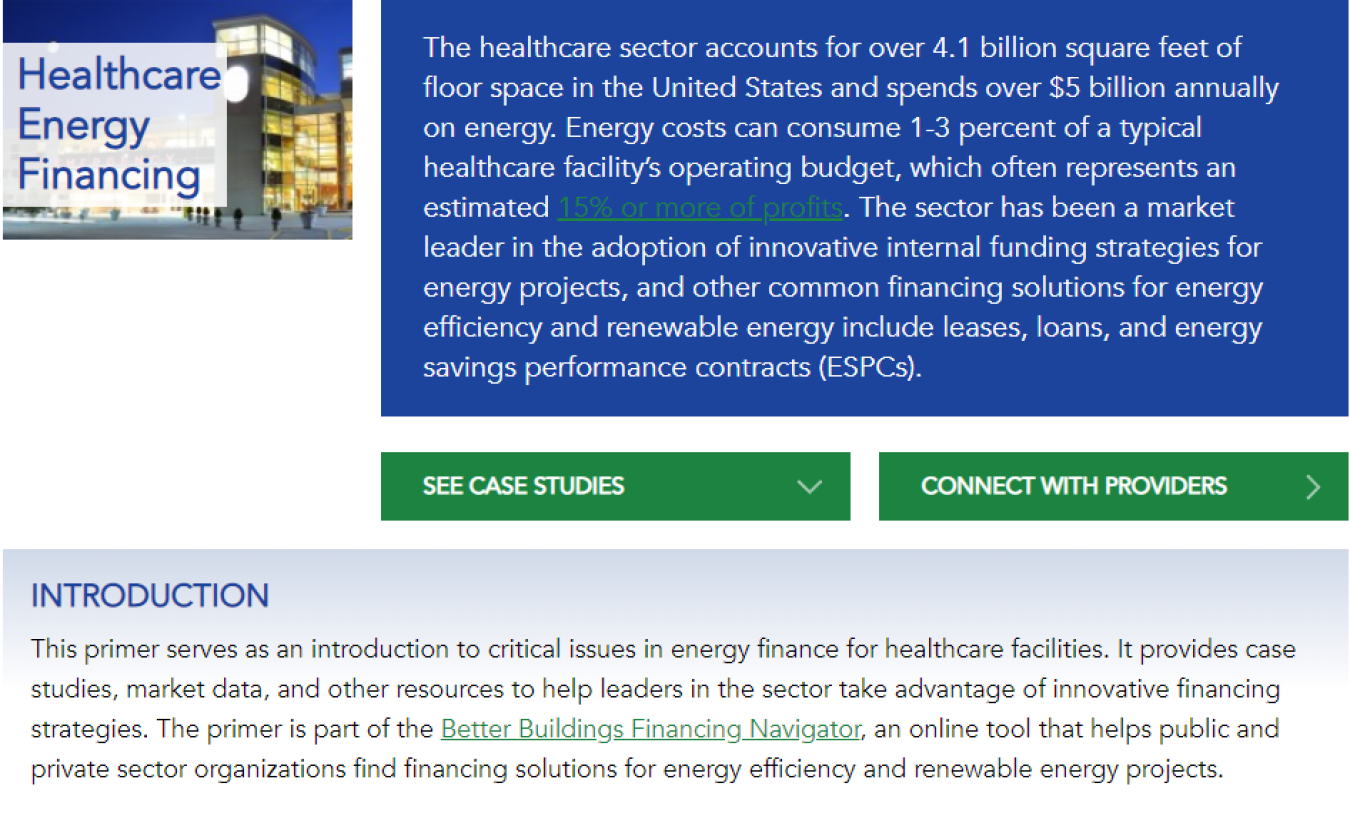The U.S. Department of Energy released a new Better Buildings Initiative resource, the Healthcare Financing Primer.
September 11, 2019
A snapshot of the Better Buildings Financing Navigator’s newly released Healthcare Financing Primer.
The U.S. Department of Energy released a new Better Buildings Initiative resource, the Healthcare Financing Primer, to help organizations take advantage of financial strategies to implement energy-efficiency projects in the healthcare sector. The primer explains how the healthcare sector’s energy-intensive buildings can overcome common financial barriers to successfully administer efficiency projects that result in energy savings, increased affordability, and improved occupant comfort. It is one of the many Better Buildings resources that help specific sectors work toward achieving their energy savings goals by accelerating funding and sharing best practices.
The healthcare sector in particular has an enormous potential for cost-savings as, according to the Better Buildings Progress Report, healthcare organizations in the United States spend more than $6.5 billion each year on energy costs. The sector alone accounts for more than 4.1 billion square feet of floor space in the U.S. and faces numerous challenges when considering energy upgrades in these facilitates.
The high upfront capital cost of energy-efficiency projects can create barriers for the adoption and implementation of energy conservation measures. However, there are financing methods available that help building stakeholders overcome that initial cost to receive the long-term benefits of increased efficiency. Different approaches can enable organizations to pay for the efficiency project over time through mechanisms like loans, leases, and efficiency-as-a-service.
In addition to high upfront capital costs, each sector has its own unique challenges that may impact how an organization chooses to approach financing for energy projects. For example, hospitals and other healthcare buildings may have stringent environmental and operational requirements that may increase the cost or disruption of efficiency projects. Healthcare organizations looking to reduce their energy spending can take advantage of financing solutions like energy savings performance contracts (ESPCs) and green revolving funds. Notably, healthcare has been a leading sector in the implementation of ESPCs along with municipalities, universities, and schools. The Healthcare Financing Primer can help organizations navigate these different approaches and find solutions that work best for their unique situation and priorities.
“Every healthcare organization needs to have a disciplined approach to financing energy efficiency because these investments allow them to redirect money to patient care in a time when healthcare is moving to provide value,” explained Jon Utech, director of the Office for a Healthy Environment at the Cleveland Clinic. “The approaches described in this toolkit allow anyone to find a model that fits with their operating philosophy.”
The Healthcare Financing Primer is part of a wider Better Buildings series that includes the Higher Education Financing Primer, which was released in 2018. The Higher Education Financing Primer serves as an overview to critical issues in energy finance for higher education and provides case studies, market data, and other resources to help leaders in the sector utilize financing strategies. Through the resources provided by Better Buildings, the higher education sector with its 5 billion square feet of floor space in the U.S. has the opportunity to reduce the estimated $6 billion it spends annually on energy costs.
“The potential for us to find energy savings on the Washington College campus is tremendous,” said Gregory Farley, director of Sustainability at Washington College. “We have many buildings that date to the early 1900s, and a few are stretch back to mid-1800s. While our newer buildings are more efficient, there's a lot of opportunity in our infrastructure. As we renovate and upgrade our facilities, we are seeking improvements in heating and cooling, building envelopes, and lighting. I think a 30% reduction in our energy bills is achievable in the near to medium term. The principles outlined in this primer can help any institution navigate financing for their own efficiency goals.”
The Higher Education Financing Primer also examines common barriers to energy financing for universities and other higher education institutions. These organizations often face some of the same challenges as the healthcare sector, including limited staff capacity, competing budget priorities, and the potential for resistance from leadership. But campuses also need to deal with older buildings and outdated or inefficient systems, which creates the potential for larger cost and energy savings. Regardless of the barrier, the financing primers can provide direction to leaders like Mr. Farley and Mr. Utech who are working to improve efficiency in their sector.
This new resource joins the Better Buildings Financing Navigator, an online tool where public and private organizations can find information on securing financing for future energy projects. The navigator helps users understand their unique sector’s financial landscape to compare options and connect their organizations to financing providers. Prospective users may include building owners, facility and energy managers, sustainability directors, executives, contractors, consultants, brokers, researchers, or others who want to learn more about the marketplace in general.
Through the Better Buildings Initiative, DOE’s Building Technologies Office works to improve energy affordability and accelerate energy-efficiency funding across all sectors.

